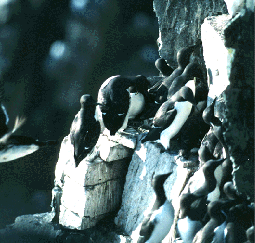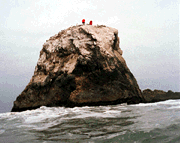
HIGH-TECH
DECOYS LURE SEABIRDS BACK TO AN ABANDONED NESTING SITE.
BIOLOGIST
MIKE PARKER is a magician. He needs no smoke, but he does use mirrors
-- mirrors, decoys, and loudspeakers. His audience is a seabird called
the common murre, and his trick is to lure the birds back to a breeding
site they abandoned after an oil spill more than a decade ago.
Murres breed in loud, crowded colonies on narrow
cliff ledges. Parker and his colleagues from the San Francisco Bay National
Wildlife Refuge want to convince the birds that the abandoned site,
Devil's Slide Rock, is the hot, hip place to breed. The decoys, mirrors,
and amplified recordings of murre calls are supposed to assure murres
still looking for a place to settle down that everyone is doing it here.
 It isn't easy. Devil's Slide Rock island juts 70
feet out of the Pacific Ocean. Waves crash at its base; its sides are
steep and ocean-sprayed, and the top -- where the team of biologists
arranges the wood and plastic mock murres in their best approximation
of a thriving colony -- is slick and smelly from years of accumulated
guano.
It isn't easy. Devil's Slide Rock island juts 70
feet out of the Pacific Ocean. Waves crash at its base; its sides are
steep and ocean-sprayed, and the top -- where the team of biologists
arranges the wood and plastic mock murres in their best approximation
of a thriving colony -- is slick and smelly from years of accumulated
guano.
"They said it couldn't be done," says Harry Carter,
a murre man who collaborates on the restoration project. When other
seabird biologists heard about the proposed plan four years ago, "they
said it was too dangerous. They said it would be impossible to work
on that rock."
next
>>
|


 It isn't easy. Devil's Slide Rock island juts 70
feet out of the Pacific Ocean. Waves crash at its base; its sides are
steep and ocean-sprayed, and the top -- where the team of biologists
arranges the wood and plastic mock murres in their best approximation
of a thriving colony -- is slick and smelly from years of accumulated
guano.
It isn't easy. Devil's Slide Rock island juts 70
feet out of the Pacific Ocean. Waves crash at its base; its sides are
steep and ocean-sprayed, and the top -- where the team of biologists
arranges the wood and plastic mock murres in their best approximation
of a thriving colony -- is slick and smelly from years of accumulated
guano.